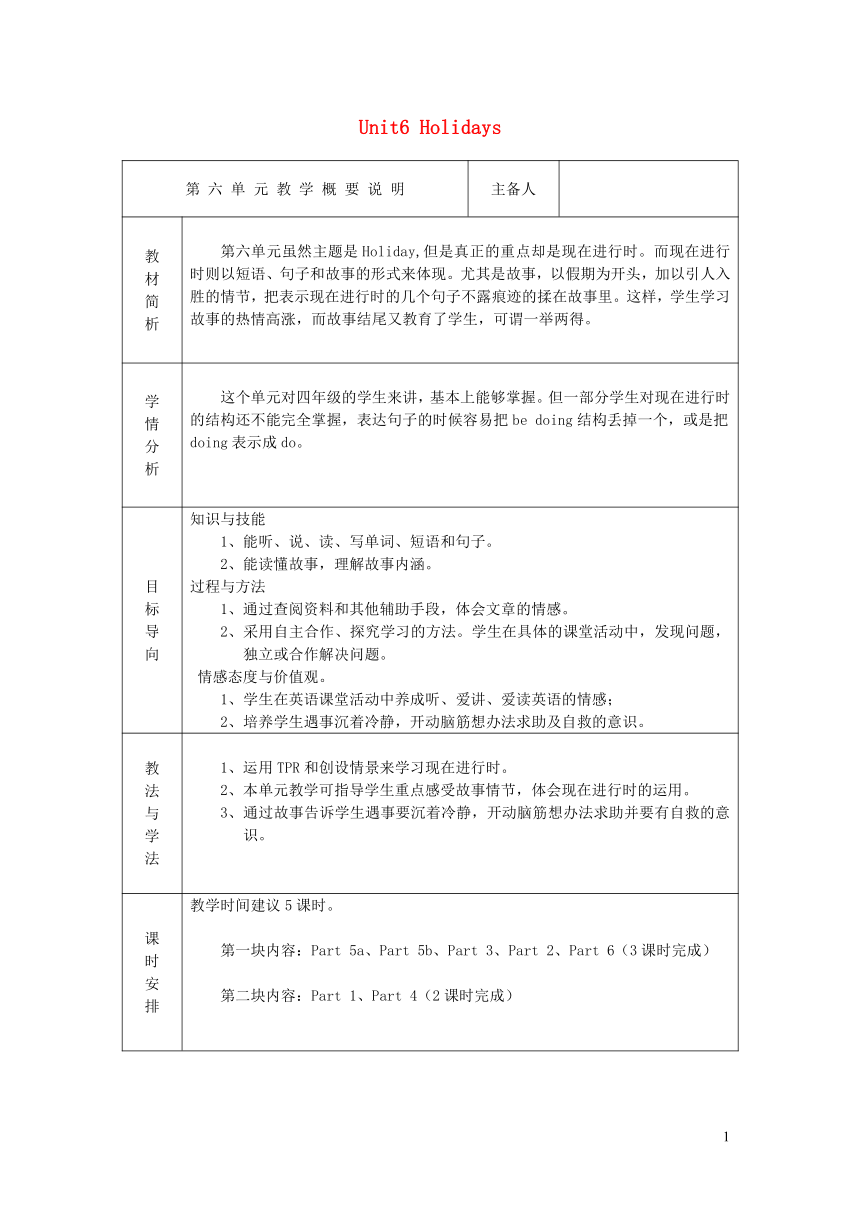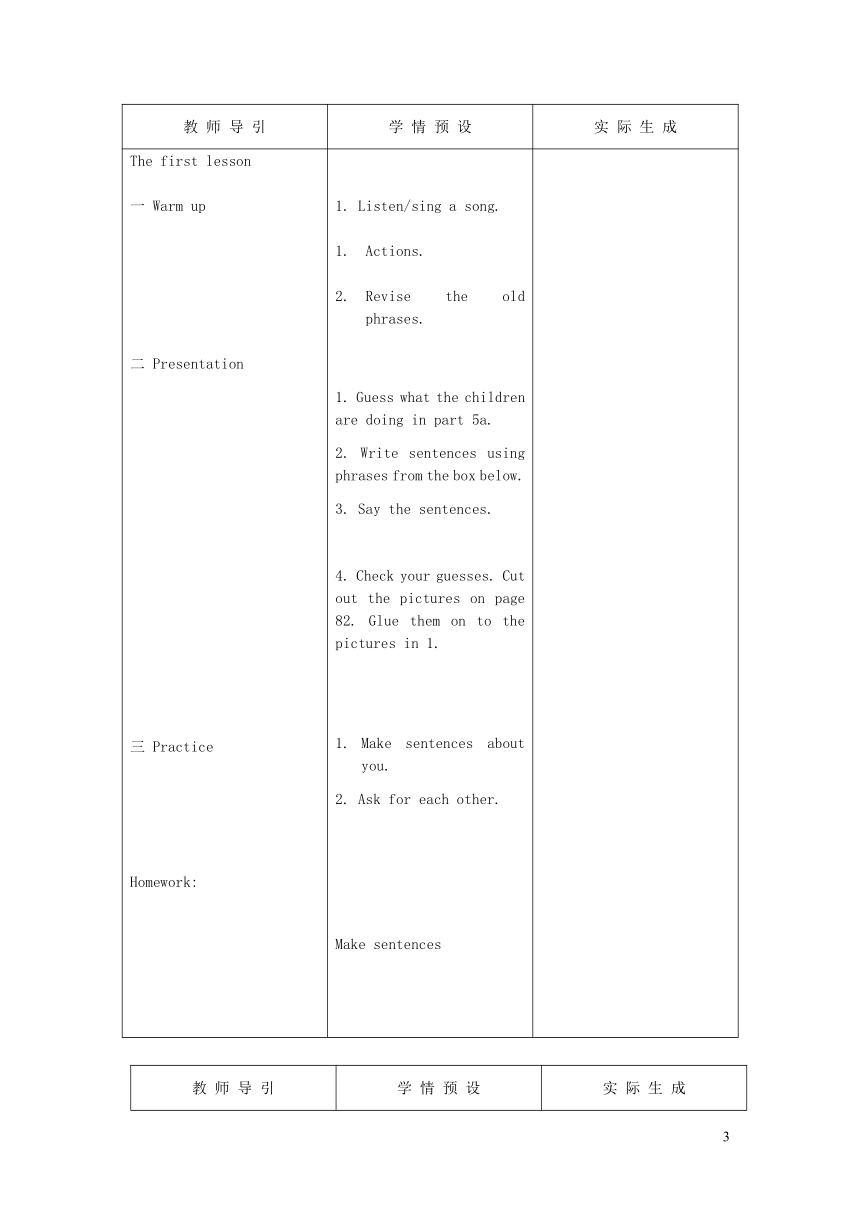Unit6 Holidays 教案
文档属性
| 名称 | Unit6 Holidays 教案 |  | |
| 格式 | zip | ||
| 文件大小 | 70.5KB | ||
| 资源类型 | 教案 | ||
| 版本资源 | 外研版(刘兆义主编) | ||
| 科目 | 英语 | ||
| 更新时间 | 2020-06-03 07:37:54 | ||
图片预览




文档简介
第 六 单 元 教 学 概 要 说 明 主备人
教 材 简 析 第六单元虽然主题是Holiday,但是真正的重点却是现在进行时。而现在进行时则以短语、句子和故事的形式来体现。尤其是故事,以假期为开头,加以引人入胜的情节,把表示现在进行时的几个句子不露痕迹的揉在故事里。这样,学生学习故事的热情高涨,而故事结尾又教育了学生,可谓一举两得。
学 情 分 析 这个单元对四年级的学生来讲,基本上能够掌握。但一部分学生对现在进行时的结构还不能完全掌握,表达句子的时候容易把be doing结构丢掉一个,或是把doing表示成do。
目 标 导 向 知识与技能 1、能听、说、读、写单词、短语和句子。 2、能读懂故事,理解故事内涵。 过程与方法 1、通过查阅资料和其他辅助手段,体会文章的情感。 2、采用自主合作、探究学习的方法。学生在具体的课堂活动中,发现问题,独立或合作解决问题。 情感态度与价值观。 1、学生在英语课堂活动中养成听、爱讲、爱读英语的情感; 2、培养学生遇事沉着冷静,开动脑筋想办法求助及自救的意识。
教 法 与 学 法 1、运用TPR和创设情景来学习现在进行时。 2、本单元教学可指导学生重点感受故事情节,体会现在进行时的运用。 3、通过故事告诉学生遇事要沉着冷静,开动脑筋想办法求助并要有自救的意识。
课 时 安 排 教学时间建议5课时。 第一块内容:Part 5a、Part 5b、Part 3、Part 2、Part 6(3课时完成) 第二块内容:Part 1、Part 4(2课时完成)
Unit6 Holidays
课 题 主备人 主讲人 授课日期 缺课学生
Unit6 Holidays
教 学 目 标 知识与技能 Master the new words and phrases. Say and write the sentences. Can talk about the holiday.
过程与方法 循序渐进教学法和TPR.
情感态度 价值观 To keep healthy every day. Have a nice holiday.
重 点 表示现在进行时和假期活动的句子。 突破 方法 重点单词讲解 重点句型操练。
难 点 表示现在进行时和假期活动的句子 突破 办法 小组合作,通过练习、交流突破。
教 法 循序渐进教学法和TPR. 学法 教师引导和学生合作相结合。
教 具 准 备 卡片、CAI 课时 Five
设计理念 本设计旨在体现引导学生运用自主、合作、探究的学习方式;体现英语学习的特点;致力提高全体学生的英语听说读写能力。
板 书 设 计 Unit6 Holidays Nick is riding a bike. Pam is swimming.Jill is eating…. Tony and Cathy are playing football.Tim and Simon are playing table tennis.
教 师 导 引 学 情 预 设 实 际 生 成
The first lesson 一 Warm up 二 Presentation 三 Practice Homework: 1. Listen/sing a song. Actions. Revise the old phrases.1. Guess what the children are doing in part 5a. 2. Write sentences using phrases from the box below. 3. Say the sentences. 4. Check your guesses. Cut out the pictures on page 82. Glue them on to the pictures in 1. Make sentences about you.2. Ask for each other. Make sentences
教 师 导 引 学 情 预 设 实 际 生 成
The second lesson 一 Warm up 二 Presentation Now let’s learn part 1Children from all over the world talk about their holidays.Tell the pupils to ask their classmates questions about the photographs holidays and leisure time in general, for example :Do you like this girl? Can you serf? Guide the pupils to a certain extent. But you are guided by the pupils’ interests, too. 三 PracticeThe third lesson 一 Warm up Teach them to know:The moon is bright, there’s a party tonight. The lion and the duck are dancing rock’n’roll. 1. Sing a song. Actions. 1. A-guessing game: What am I doing? 2. Make the sentences using be doing. The pupils talk about and compare them with the information provided by the children in the photographs. Read and write the sentences. 1. Listen and sing the song.2. Read and sing the song again.
教 师 导 引 学 情 预 设 实 际 生 成
二 Presentation Learn the part 8.1. Let the pupils look at the pictures. Then ask : What is he/she doing?What are they doing?Teach them to use: She / He is doing…. They are doing…. Notice: ride——riding have----having dance----dancing write----writing swim----swimming put-----putting Let the pupils look at the pictures. Then ask : What is he/she doing?What are they doing? The fourth lesson 一warm upGreetingHello, Nice to meet you.Free talkDo you like holidays? What do you do in holidays? 1. Watch and read.Look at the pictures and answer. 1. Answer the questions. Laura is painting a picture. Martin is eating spaghetti. Jane is watching TV. Lisa is singing. Maria and Dan are swimming. Tom and Sue are playing. She is writing. He is playing the piano. He is skiing. 2.Write the sentences 3. Copy the sentences. Nice to meet you, too.
教 师 导 引 学 情 预 设 实 际 生 成
二 lead in 1. Look, what’s this? Yes, it’s a big house. It looks very nice. Let’s go and have a look, OK? Oh, there are many rooms in this house, what are they? 三Presentation Teach: bathroom、bedroom、living room、kitchenSpell: kit ch en ba thWhat can we do in the bathroom/bedroom/living room/kitchen? 3. Teach new phrases: have a bath, wash the dishesby TPR. 4.Show the picture of writing “sweet home”. It’s really a nice house. I hope this is my home, sweet home. 5. Today we will learn a story-The monster. All the things take place in this house. Please read this story silently. Try to understand it. Show the question: What is this story talking about? (1). Learn part one of the story. It’s a house. OK. Let’s go! Read after the teacher. We can…in the…. Learn new phrases. Say: home, sweet home Read the story silently. Intensive reading
教 师 导 引 学 情 预 设 实 际 生 成
Read picture one loudly. Show: Whose house is it? What are the mouse and the hamster going to do? . Learn part two of the story. The mouse and the hamster are going out for their holidays, only the rabbit left at home. Let’s watch the pictures. Show: What will happen? Four big animals rush into the house, who are they? What are they doing in the house? What is the hippo doing? What is the lion doing? What are the fox and the snake doing? What is the rabbit doing? Look at the four big animals, how are they feeling now? What about the rabbit? Whose house is it at this time?They are robber (强盗). Read picture one loudly. It’s the mouse、hamster and the rabbit’s. They’re going for their holidays. They are hippo, lion, fox and snake.Read the text loudly. In the bathroom a hippo is having a bath. In the bedroom the lion is watching TV. In the living room a fox and a snake are playing table tennis. In the kitchen the rabbit is washing the dishes. Practice the sentences. They are very happy. The rabbit is sad/ tired…. The four big animals’. How are you feeling now?
教 师 导 引 学 情 预 设 实 际 生 成
Let’s find a good way to help the small animals. Learn part three of the story. The hamster and the mouse are angry, too. They have got an idea. OK, let’s look! Show: What’s the idea? When the big animals look at the crocodile, how are they feeling? What do they say? Who is it? Is it a crocodile? Whose house is it at last? What the clever animal! Which animal do you like best in this story? Why? we are in danger, We should get help from others or help ourselves. I believe you can. Class is over, good bye. Let them talk about freely. Look at the picture. They are scared.Who’s knocking? The big crocodile. Help! Help! The mouse and hamster. No. The mouse, hamster and rabbit’s.Say it freely. Read and act the story. Bye –bye.
教 学 反 思
9
